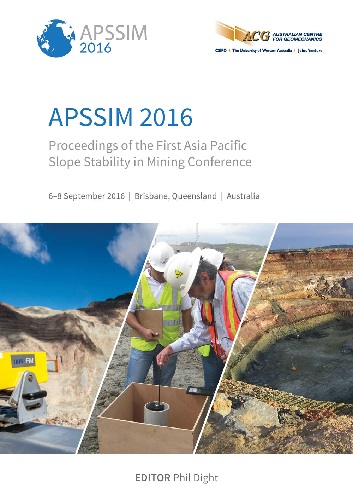Influence of salinity and suction on slope stability in transported material

|
Authors: Dight, PM; Hong, Q; Dyskin, A; Pasternak, E |
DOI https://doi.org/10.36487/ACG_rep/1604_01_Dight
Cite As:
Dight, PM, Hong, Q, Dyskin, A & Pasternak, E 2016, 'Influence of salinity and suction on slope stability in transported material', in PM Dight (ed.), APSSIM 2016: Proceedings of the First Asia Pacific Slope Stability in Mining Conference, Australian Centre for Geomechanics, Perth, pp. 97-106, https://doi.org/10.36487/ACG_rep/1604_01_Dight
Abstract:
Slope design in the regolith comprising weathered rock and transported materials is often very conservative. This arises from the use of conventional laboratory testing using saturated samples. In Western Australia, many of the mines are located in areas of high salinity. When materials recovered for testing are located above the water table they are most likely to be affected by suction. In this paper the authors will present the results of testing materials recovered from a gold mine where the in situ water content was approximately 20% while the saturated water content was approximately 50%. The material had a permeability of approximately 10⁻¹⁰ m/s and comprised over 40% clay size material. The salinity was approximately 7,000 ppm. Suction comprises matric and osmotic suction. The test work shows that the osmotic suction had the most significant effect on reducing the in situ water content and raising the shear strength parameters. This had a big impact on understanding of slope stability in these materials. The dispersive nature of the material subsequently influenced stability when approaching the ground water table but for unforeseen reasons. The paper shows how the slope was then stabilised.
Keywords: slope stability, suction, salinity weathered materials
References:
Fredlund, DG, Rahardjo, H & Fredlund, MD 2011, Unsaturated Soil Mechanics in Engineering Practice, John Wiley & Sons, Inc., p. 926.
O’Connor, B 2010, Gold occurrence in Western Australia map, Gold Prospecting in Western Australia, viewed 6 July 2016,
www.gold-prospecting-wa.com
Wetzel, RG 2001, Limnology: Lake and River Ecosystems, 3rd ed, Academic Press.
© Copyright 2025, Australian Centre for Geomechanics (ACG), The University of Western Australia. All rights reserved.
View copyright/legal information
Please direct any queries or error reports to repository-acg@uwa.edu.au
View copyright/legal information
Please direct any queries or error reports to repository-acg@uwa.edu.au